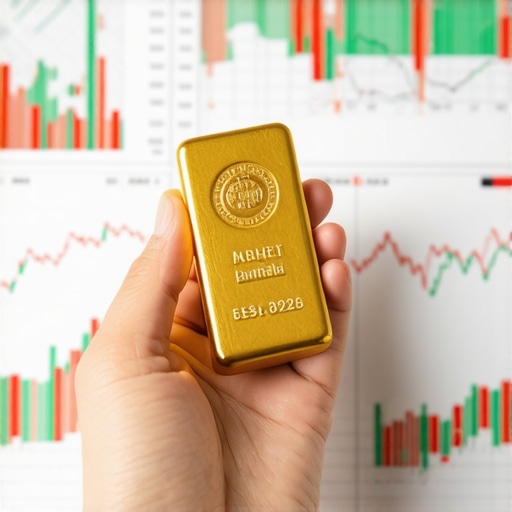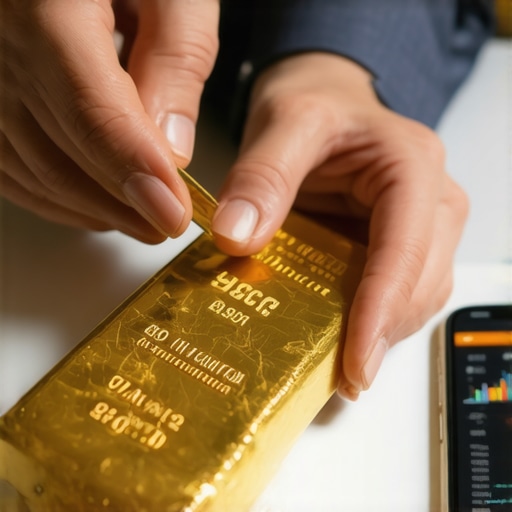Unlocking the Golden Gateway: Why New Investors Must Tread Carefully
Investing in gold can be a rewarding way to diversify portfolios and hedge against inflation, but for beginners, it’s a terrain riddled with pitfalls. Many novice investors jump in attracted by gold’s glittering reputation without fully understanding its nuances, often resulting in costly mistakes. This guide aims to illuminate the common errors newcomers make, ensuring your first steps into the precious metals market are confident and informed.
Shattering Illusions: Common Missteps That Sabotage Gold Investments
Overlooking the Difference Between Physical and Paper Gold
One of the most frequent mistakes is failing to distinguish between physical gold—such as coins and bars—and paper gold, like ETFs or mutual funds. Each has unique risk profiles, liquidity, and storage considerations. New investors often buy physical gold without planning secure storage, exposing themselves to theft or loss. Conversely, relying solely on gold ETFs without understanding market volatility can lead to unexpected losses.
Chasing Price Trends Without a Strategy
Gold prices fluctuate due to complex factors including geopolitical tensions, currency strength, and central bank policies. Beginners sometimes try to time the market impulsively, buying high during spikes and selling low during dips. Developing a disciplined approach aligned with long-term financial goals is crucial to avoid emotional decisions that erode returns.
Expert Insights: How to Build a Resilient Gold Portfolio
Seasoned investors emphasize diversification within gold investments. Combining physical gold with ETFs or gold mining stocks can balance risk and liquidity. Additionally, understanding supply and demand dynamics, such as those detailed in expert analyses on gold supply and demand trends, equips investors to anticipate market shifts effectively.
What Are the Essential Safeguards for Beginners When Buying Physical Gold?
Purchasing physical gold requires vigilance. Beginners should only buy from reputable dealers and insist on verifiable certification to avoid counterfeits. Secure storage solutions, whether through bank safety deposit boxes or insured home safes, are non-negotiable to protect your investment. For practical guidance, explore best practices in physical gold storage and security.
Transforming Knowledge into Action: Your Invitation to Engage
Have you encountered challenges in your gold investment journey or have tips to share? Join the conversation by leaving a comment below or sharing this article with fellow aspiring investors. For a more comprehensive roadmap, consider reading our expert guide on building your first gold portfolio.
According to the World Gold Council, gold remains a cornerstone of wealth preservation globally, but success depends on understanding its multifaceted nature and avoiding impulsive decisions (World Gold Council).
When Market Volatility Hits: Lessons from My First Gold Investment Rollercoaster
I still vividly remember the adrenaline rush when I first bought gold during a sudden price surge. It felt like striking gold—literally. But within weeks, the price dipped unexpectedly, and my excitement turned into anxiety. This experience taught me an invaluable lesson: gold investing, while often viewed as a safe haven, isn’t immune to volatility. It reinforced the importance of patience and a clear strategy rather than chasing quick gains.
Understanding the factors behind these price swings helped me stay grounded. For example, geopolitical tensions or shifts in central bank policies can cause sudden market movements. I found that staying informed through reliable sources, like the analysis of central bank gold purchases, provided context that eased my worries and helped me avoid knee-jerk reactions.
Balancing Physical Gold and Paper Gold: A Personal Portfolio Experiment
Early on, I grappled with deciding how much to allocate to physical gold versus gold ETFs. I started mostly with physical gold coins, loving the tangible aspect, but soon realized the challenges of secure storage and liquidity. Over time, I diversified into ETFs, appreciating their ease of trading and cost efficiency.
This balance suited my goals better: physical gold as a long-term hedge and ETFs for tactical maneuvers. If you’re curious about how to tailor this balance to your needs, check out our detailed insights on types of gold investments.
How Do You Decide the Right Mix Between Physical and Paper Gold for Your Portfolio?
Choosing the right allocation depends on your risk tolerance, investment horizon, and liquidity needs. Reflecting on my journey, I realized that starting small with physical gold helped build confidence, while gradually incorporating ETFs provided flexibility.
What’s your approach? Do you prefer the security of physical gold or the convenience of paper gold? Share your thoughts below—I’d love to hear your experiences and strategies.
Securing Your Treasure: Real-World Tips for Safe Storage
After my first physical gold purchase, I faced the daunting question: where to keep it safe? Initially, I tried a home safe but quickly felt uneasy about potential theft or damage. Eventually, I opted for a bank safety deposit box, which gave peace of mind despite the access limitations.
For those exploring storage solutions, it’s worth reading up on best practices for physical gold storage to understand options and costs. Proper storage is critical—not just for safety but also for maintaining the gold’s resale value.
Decoding the Intricacies of Gold Market Dynamics: Beyond the Surface
Gold’s price movements are far from arbitrary; they are influenced by a sophisticated interplay of macroeconomic variables, geopolitical events, and market sentiment. Experienced investors recognize that factors such as real interest rates, U.S. dollar strength, and inflation expectations are critical drivers. For instance, a decline in real interest rates typically boosts gold’s appeal as a non-yielding asset, enhancing demand and pushing prices higher. Equally, geopolitical tensions can trigger safe-haven buying, while shifts in central bank policies — including gold reserve adjustments — can signal long-term trends.
To navigate these complexities, investors must leverage comprehensive data analytics and maintain an adaptive outlook. Incorporating forward-looking indicators and scenario analysis can provide a decisive edge in anticipating market inflection points. For rigorous empirical insights, the World Gold Council’s Gold Research Hub offers in-depth studies that decode these multifaceted influences.
How Can Sophisticated Investors Model Gold Price Volatility to Enhance Portfolio Resilience?
Advanced investors employ quantitative models like GARCH (Generalized Autoregressive Conditional Heteroskedasticity) to capture and forecast the volatility clustering patterns inherent in gold prices. Additionally, regime-switching models help detect market phase changes—distinguishing between calm and turbulent periods—which is vital for timing entry and exit points. Integrating these models with macroeconomic indicators enhances predictive accuracy and risk management.
Moreover, stress testing portfolios against historical gold market shocks and hypothetical geopolitical crises enables investors to gauge potential drawdowns and calibrate exposure accordingly. Such rigorous risk assessment frameworks are indispensable for constructing a robust gold allocation that complements broader portfolio objectives.
Leveraging Derivatives and Structured Products: Unlocking Sophisticated Exposure to Gold
Beyond physical gold and ETFs, seasoned investors explore derivatives like options and futures to tactically manage risk and capitalize on short-term market inefficiencies. Options strategies—such as collars, spreads, and straddles—allow nuanced positioning on volatility and directional moves without committing full capital to owning gold outright. Futures contracts enhance liquidity and enable hedging against price fluctuations.
Structured products linked to gold indices or baskets of mining equities provide tailored risk-return profiles and can incorporate leverage or capital protection features. However, these instruments require deep familiarity with underlying mechanics, counterparty risk, and regulatory considerations. Engaging with specialized financial advisors or institutional-grade research platforms is recommended before venturing into these complex vehicles.
Integrating Environmental, Social, and Governance (ESG) Criteria in Gold Investment Decisions
The rising prominence of ESG factors is reshaping investment paradigms, including in the precious metals sector. Investors increasingly scrutinize the environmental impact of gold mining operations, labor practices, and governance transparency. Sustainable gold sourcing—such as certified recycled gold or mines adhering to rigorous social standards—adds an ethical dimension to portfolio construction.
Incorporating ESG metrics not only aligns investments with responsible values but can also mitigate long-term risks related to regulatory changes, reputational damage, or operational disruptions. Comprehensive ESG scoring systems and third-party certifications facilitate this evaluation, enabling investors to make informed choices that balance financial performance with sustainability.
Practical Steps to Elevate Your Gold Investment Strategy Today
To refine your gold investment approach, start by conducting a thorough portfolio audit that assesses current gold exposure relative to your risk appetite and financial goals. Engage with expert analyses and stay abreast of evolving market trends through authoritative resources like the World Gold Council.
Consider diversifying across multiple gold investment vehicles and integrating advanced risk management tools such as volatility modeling and scenario planning. Don’t hesitate to consult with financial professionals who specialize in precious metals to tailor strategies that resonate with your unique circumstances.
Ready to deepen your expertise and optimize your gold portfolio? Subscribe to our newsletter for cutting-edge insights, expert interviews, and comprehensive analyses designed to empower your investment journey.
Harnessing Quantitative Analytics: Modeling Gold Price Volatility for Strategic Edge
Sophisticated investors recognize that gold’s price volatility is not merely random noise but exhibits distinctive patterns amenable to advanced statistical modeling. Techniques such as the GARCH (Generalized Autoregressive Conditional Heteroskedasticity) framework enable the capture of volatility clustering, a phenomenon where high-volatility periods tend to beget further turbulence. Additionally, regime-switching models discern shifts between calm and turbulent market phases, offering critical insights for timing exposure adjustments. When combined with macroeconomic indicators—like real interest rates and inflation expectations—these models sharpen predictive accuracy, allowing portfolio managers to anticipate inflection points and mitigate downside risks proactively.
How Can Sophisticated Investors Model Gold Price Volatility to Enhance Portfolio Resilience?
By integrating quantitative volatility models with scenario-based stress testing, investors construct robust frameworks that simulate responses to historical shocks and hypothetical geopolitical crises. This dual approach enables precise calibration of gold allocations to buffer against severe drawdowns while capitalizing on upside potential. Leveraging econometric tools alongside real-time data feeds facilitates dynamic risk management—a vital capability in the ever-evolving gold market landscape.
Innovative Instruments: Unlocking Value Through Derivatives and Structured Products
Beyond traditional holdings, derivatives such as gold options and futures provide sophisticated avenues to tailor risk exposures and exploit short-term market inefficiencies. Options strategies—including collars, vertical spreads, and straddles—allow nuanced bets on volatility and directional moves without full capital commitment to the underlying metal. Futures offer unparalleled liquidity and can hedge against adverse price swings effectively. Meanwhile, structured products tied to gold indices or baskets of mining equities enable bespoke risk-return profiles, often incorporating leverage or principal protection. However, the complexity and counterparty risks inherent in these instruments necessitate collaboration with seasoned financial advisors and rigorous due diligence.
Embedding ESG Criteria: Elevating Gold Investments with Responsible Stewardship
The increasing salience of Environmental, Social, and Governance (ESG) factors is reshaping gold investment paradigms. Investors now prioritize sourcing gold from operations that demonstrate stringent environmental management, fair labor practices, and transparent governance frameworks. Certified recycled gold and mines adhering to recognized sustainability standards mitigate risks related to regulatory shifts and reputational damage, while aligning portfolios with ethical mandates. Utilizing comprehensive ESG scoring methodologies and third-party certifications empowers investors to integrate sustainability without compromising financial objectives, fostering long-term resilience amid evolving stakeholder expectations.
Expert Resources: Deepening Knowledge Through Authoritative Research
For those aspiring to master the complexities of gold investing, the World Gold Council’s Gold Research Hub offers unparalleled empirical studies and market insights. These resources provide granular data on supply-demand dynamics, price drivers, and ESG integration, underpinning evidence-based decision-making. Engaging regularly with such authoritative platforms enhances analytical rigor and strategic foresight.
Elevate Your Gold Investment Mastery Today
Are you ready to transcend basic gold investing and architect a sophisticated, resilient portfolio? Embrace advanced volatility modeling, explore derivative instruments judiciously, and integrate ESG principles to future-proof your investments. Connect with our expert community by subscribing to our newsletter for exclusive analyses, interviews with industry leaders, and actionable strategies tailored to seasoned investors.
Frequently Asked Questions (FAQ)
What are the key differences between physical gold and paper gold investments?
Physical gold involves tangible assets like coins and bars, offering direct ownership and a hedge against currency risks, but requires secure storage and insurance. Paper gold includes ETFs, mutual funds, and derivatives, providing greater liquidity and ease of trading but exposing investors to market volatility, counterparty risks, and sometimes management fees. Understanding these differences is crucial for aligning gold exposure with portfolio objectives and risk tolerance.
How can new investors avoid common pitfalls when entering the gold market?
Beginners should avoid impulsive buying driven by price hype, ensure purchases are from reputable dealers with verifiable certifications, establish secure storage solutions, and develop a disciplined investment strategy aligned with long-term financial goals. Educating oneself about market drivers and diversifying exposure across investment vehicles also mitigates risks and enhances portfolio resilience.
What advanced methods do sophisticated investors use to model gold price volatility?
Experienced investors apply quantitative models such as GARCH to capture volatility clustering and regime-switching models to identify shifts between calm and turbulent market phases. Combining these with macroeconomic indicators and scenario-based stress testing allows for dynamic risk management and precise calibration of gold allocations to withstand market shocks and capitalize on opportunities.
How can derivatives and structured products enhance gold investment strategies?
Derivatives like options and futures enable tactical risk management and leveraged exposure to gold price movements without full capital commitment. Structured products linked to gold indices or mining equities offer customizable risk-return profiles, including principal protection and leverage. These instruments require advanced knowledge, careful due diligence, and often collaboration with financial advisors to navigate complexity and counterparty risks effectively.
Why is integrating ESG criteria important in gold investing?
ESG integration addresses the environmental impact, social responsibility, and governance standards of gold mining and sourcing. Investing in certified recycled gold or mines adhering to strict sustainability standards mitigates regulatory, reputational, and operational risks, aligns portfolios with ethical values, and contributes to long-term resilience amid evolving stakeholder expectations.
What practical steps can investors take today to improve their gold investment portfolios?
Start with a comprehensive portfolio audit to assess current gold exposure relative to risk tolerance and goals. Diversify across physical gold, ETFs, and possibly derivatives while employing volatility modeling and scenario analysis for risk management. Stay informed via authoritative sources like the World Gold Council and consult experts specializing in precious metals to tailor strategies effectively.
How do geopolitical events and macroeconomic factors influence gold prices?
Gold prices are sensitive to geopolitical tensions, real interest rates, inflation expectations, and central bank policies. For example, heightened geopolitical risk often triggers safe-haven buying, while declining real interest rates increase gold’s attractiveness as a non-yielding asset. Understanding these drivers helps investors anticipate price movements and adjust their strategies accordingly.
What are the best practices for securely storing physical gold?
Secure storage options include bank safety deposit boxes and insured high-quality home safes. Choosing reputable dealers, verifying authenticity through certifications, and regularly reviewing storage arrangements are essential. Proper storage not only protects against theft and damage but also preserves resale value and liquidity.
How should an investor decide the right mix between physical and paper gold?
The allocation depends on individual risk tolerance, liquidity needs, and investment horizon. Physical gold offers tangible security and long-term hedging benefits, while paper gold provides ease of trading and cost efficiency. A balanced approach tailored to personal goals often enhances portfolio flexibility and resilience.
Can gold investing be profitable during periods of market volatility?
Yes, gold often serves as a hedge during volatile markets due to its safe-haven status. However, gold prices themselves can be volatile. Success requires disciplined strategies, patience, and leveraging advanced analytics to navigate price fluctuations and optimize entry and exit points.
Trusted External Sources
- World Gold Council (https://www.gold.org/): The foremost authority on gold markets, providing comprehensive research on supply-demand dynamics, price drivers, ESG integration, and investment strategies tailored for both beginners and sophisticated investors.
- London Bullion Market Association (LBMA) (https://www.lbma.org.uk/): A key industry body offering standards, market data, and analysis essential for understanding the global bullion market and ensuring best practices in trading and storage.
- International Monetary Fund (IMF) – Gold Reserves Data (https://www.imf.org/en/Data): Provides authoritative statistics on central bank gold holdings and trends, critical for analyzing macroeconomic impacts on gold prices.
- Journal of Commodity Markets: A peer-reviewed academic publication offering empirical research and advanced quantitative modeling studies on gold price volatility and market behavior, aiding sophisticated investment approaches.
- Sustainability Accounting Standards Board (SASB) and Responsible Mining Initiatives: These organizations provide frameworks and certifications for ESG criteria in mining, vital for investors integrating sustainability into gold portfolios.
Conclusion
Mastering gold investments demands a nuanced understanding that spans from foundational knowledge of physical versus paper gold to sophisticated quantitative modeling and ESG integration. This article has illuminated the common pitfalls that beginners face, underscored the importance of strategic diversification, and highlighted advanced tools and instruments that seasoned investors employ to enhance portfolio resilience. As gold continues to play a pivotal role in wealth preservation amid geopolitical and economic uncertainties, informed decision-making is paramount. By leveraging authoritative research, embracing disciplined strategies, and aligning investments with responsible stewardship principles, investors can unlock gold’s full potential while managing inherent risks.
Embark on your gold investment journey with confidence—share your insights, engage with the expert community, and explore our comprehensive resources to elevate your portfolio strategy. Your path to sophisticated, resilient gold investing starts today.











I really appreciate how this article highlights the importance of understanding the difference between physical and paper gold, especially for beginners. When I first started, I was solely focused on buying physical gold coins because I liked the tangible aspect, but I didn’t give much thought to storage. After a minor scare about home security, I realized that secure storage is crucial — opting eventually for a bank safety deposit box brought peace of mind despite the inconvenience. What resonated with me most was the advice against chasing price trends without a clear strategy; impulsive buying during price spikes nearly set me back financially. I’m curious about how other investors balance their gold portfolios between physical and paper forms. Have others found that a mixed approach offers more resilience? Also, how do you manage the emotional challenges when gold prices are volatile? Sharing some real-world experiences or tips on maintaining discipline would be a great help for those new to this. Overall, this article does a great job of steering beginners away from common pitfalls while encouraging informed and strategic investing.
Melissa, your reflection on balancing physical and paper gold really resonates with me. In my early days of investing, I was similarly attracted to the tangibility of physical gold but overlooked the importance of liquidity until I encountered unexpected market swings. What helped me was gradually introducing gold ETFs into my portfolio, which provided an accessible way to adjust positions without the hassle of storage issues. Regarding the emotional rollercoaster during volatility, I found that establishing a clear investment plan—rooted in long-term objectives rather than short-term market noise—made a huge difference. Regularly reviewing credible analyses on market drivers, like geopolitical events or central bank activities, also helped contextualize price movements and reduce anxiety. Have you or others found success in setting predefined rules for buying or selling gold to avoid impulsive decisions? What strategies do you think can help beginners develop that kind of discipline, especially when prices swing drastically? I’d be interested in hearing more about different approaches to maintaining composure and sticking to a strategy amid the inherent ups and downs of the gold market.
The point about avoiding impulsive decisions when investing in gold really stood out to me. Early in my investing journey, I also fell into the trap of chasing price trends, especially during sudden gold price surges. The adrenaline and fear of missing out often clouded my judgment, leading to some poorly timed purchases. What helped me regain control was setting clear investment goals focused on long-term wealth preservation rather than short-term gains. I also started tracking geopolitical and economic indicators to understand what influences gold prices beyond just market hype. Regarding the physical versus paper gold debate, I believe the right balance depends heavily on an individual’s situation — physical gold offers tangible security but requires trusted storage, while paper gold provides flexibility but demands a comfort level with market volatility. Has anyone experimented with setting automated rules or alerts for buying or selling gold to help curb emotional decision-making? I’m interested in how others integrate data and discipline to stay steady during those inevitable market swings.